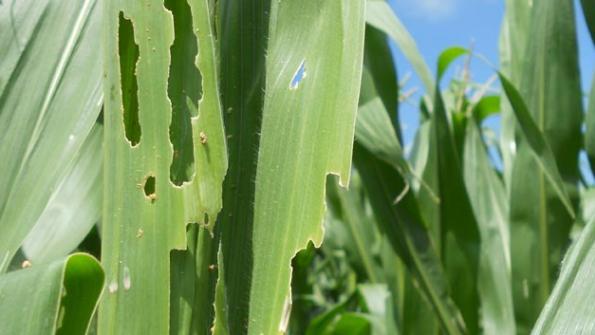
The scene: A beautiful, sunny afternoon. Walking through a flourishing cornfield with strong roots, green leaves and bright silks. Suddenly, clouds roll in, the leaves start browning and shriveling, worms eat away silks, stalks crumble in front of you as rootworms demolish the roots, and charcoal rot erodes the stalks. Your feel-good movie has turned into the latest horror flick.
Of course what shows up in your fields depends on several factors, from drought to heat to a moisture overload, and nothing at this point is certain. Extension specialists from across the Corn Belt have offered their predictions about what to expect in your cornfield this growing season.
"It is always fun to put on the prognosticator's hat,” says Doug Jardine, plant pathologist at Kansas State University. “For 2012, where crop rotation is not practiced, I would expect Aspergillus ear rot (aflatoxin) to be a problem again if the drought continues. The same for charcoal rot. Recent weather reports indicate perhaps a lessening of the drought in the southern half of Kansas, and that would be good news.”
Jardine expects a below-average year for southern rust, but anticipates Goss’s wilt as long as growers aren’t rotating out of corn.
His anticipation for Goss’s wilt is echoed across the Corn Belt, from Nebraska to Minnesota to Kentucky.
“The hot corn disease issue in 2011 and a key one to watch for again in 2012 is Goss's wilt,” says Dean Malvick, University of Minnesota Extension plant pathologist. “We cannot predict what will happen with this disease and whether it will be a major problem in 2012, but it will be something to watch for.
“Northern corn leaf blight was also a significant problem in some Minnesota fields in 2011, and also will be something to watch for in 2012. These and other leaf diseases such as gray leaf spot tend to be favored by regular rains and high humidity in June and July, and the weather will largely drive which diseases become important in 2012," he says.
Weather will likely play a role in which insects show up in fields, too.
“Weather can always play a role limiting or encouraging outbreaks,” says Ron Hammond, Ohio State University Extension entomologist. “The low rootworm populations we are seeing might be related to the very wet springs we have had recently. Our inability to predict what the weather will be over a long time period that can greatly affect insect populations limits our capacity to know what might or might not happen with insect populations.”
Hammond has some concern with the continuing buildup of Western bean cutworm, but says at this time in Ohio, “there is no reason to specifically plant transgenics that offer control of this insect; our populations are too low for that.”
He also has concerns about the overuse of transgenics when it comes to control of western corn rootworm, which hasn’t been a great issue in Ohio.
“The question then is whether growers need preventive actions against [western corn rootworm], assuming growers are not using a transgenic that already has genes for rootworm control – which, let’s be honest, many growers are,” he says.
The high potential for western corn rootworm is a concern for Bob Wright, University of Nebraska-Lincoln Extension Entomologist.
"We have seen increasing populations in areas without much rotation, and the winter weather to date suggests that we will have good survival of rootworms this winter," he says. "Rotation with another crop, such as soybeans, is highly recommended in these areas to reduce problems with corn rootworms."
Christian Krupke, Purdue Extension entomologist, is forecasting rootworm, as well as Western bean cutworm and black cutworm for Indiana. He'll also be on the look out for corn borers, as pressure last year was higher than it had been in a long time.
"We will look out of that again," he says. "With the reports of field resistance to Bt hybrids in Nebraska, South Dakota, Minnesota, Illinois and particularly Iowa, we have advised producers to keep a close eye on their fields, rotate control methods whenever possible and continue planting the refuge."
Hammond also suggests following IPM guidelines when growing corn.
"We're using resistance concerns to educate growers on the need for IPM: using transgenic only if needed, rotation, rotating rootworm management tactics if growing continuous corn, not relying year after year on same gene product, using pyramids, etc."
While there's still a lot of film to shoot for the 2012 growing season, and cast members like weather are uncontrollable, be sure to keep an eye on your fields for pests and diseases that could cause the horror movie, rather than the Hollywood ending.
About the Author(s)
You May Also Like




